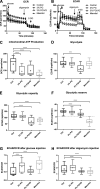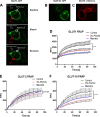E-cigarette constituents propylene glycol and vegetable glycerin decrease glucose uptake and its metabolism in airway epithelial cells in vitro
- PMID: 32996783
- PMCID: PMC7792687
- DOI: 10.1152/ajplung.00123.2020
E-cigarette constituents propylene glycol and vegetable glycerin decrease glucose uptake and its metabolism in airway epithelial cells in vitro
Abstract
Electronic nicotine delivery systems, or e-cigarettes, utilize a liquid solution that normally contains propylene glycol (PG) and vegetable glycerin (VG) to generate vapor and act as a carrier for nicotine and flavorings. Evidence indicated these "carriers" reduced growth and survival of epithelial cells including those of the airway. We hypothesized that 3% PG or PG mixed with VG (3% PG/VG, 55:45) inhibited glucose uptake in human airway epithelial cells as a first step to reducing airway cell survival. Exposure of H441 or human bronchiolar epithelial cells (HBECs) to PG and PG/VG (30-60 min) inhibited glucose uptake and mitochondrial ATP synthesis. PG/VG inhibited glycolysis. PG/VG and mannitol reduced cell volume and height of air-liquid interface cultures. Mannitol, but not PG/VG, increased phosphorylation of p38 MAPK. PG/VG reduced transepithelial electrical resistance, which was associated with increased transepithelial solute permeability. PG/VG decreased fluorescence recovery after photobleaching of green fluorescent protein-linked glucose transporters GLUT1 and GLUT10, indicating that glucose transport function was compromised. Puffing PG/VG vapor onto the apical surface of primary HBECs for 10 min to mimic the effect of e-cigarette smoking also reduced glucose transport. In conclusion, short-term exposure to PG/VG, key components of e-cigarettes, decreased glucose transport and metabolism in airway cells. We propose that this was a result of PG/VG reduced cell volume and membrane fluidity, with further consequences on epithelial barrier function. Taking these results together, we suggest these factors contribute to reduced defensive properties of the epithelium. We propose that repeated/chronic exposure to these agents are likely to contribute to airway damage in e-cigarette users.
Keywords: airway; electronic cigarettes; glucose; glycerin; propylene glycol.
Conflict of interest statement
No conflicts of interest, financial or otherwise, are declared by the authors.
J.P.G., R.T., and D.L.B. conceived and designed research; M.W., J.J., K.K.K., V.S., E.D., B.K., I.K., J.P.G., R.T., and D.L.B. performed experiments; M.W., J.J., K.K.K., V.S., E.D., B.K., I.K., J.P.G., R.T., and D.L.B. analyzed data; J.J., K.K.K., E.D., B.K., J.P.G., R.T., and D.L.B. interpreted results of experiments; M.W., J.J., K.K.K., E.D., B.K., J.P.G., R.T., and D.L.B. prepared figures; D.L.B. drafted manuscript; P.G., R.T., and D.L.B. edited and revised manuscript; M.W., J. J., J.P.G., R.T., and D.L.B. approved final version of manuscript.
Figures







References
-
- Baines DL, Baker EM. Glucose transport and homeostasis in lung epithelia. In: Lung Epithelial Biology in the Pathogenesis of Pulmonary Disease, edited by Sidhaye VK, Koval M. Oxford, UK: Academic Press, 2017, p. 33–58.
Publication types
MeSH terms
Substances
Grants and funding
LinkOut - more resources
Full Text Sources
Medical
Miscellaneous

